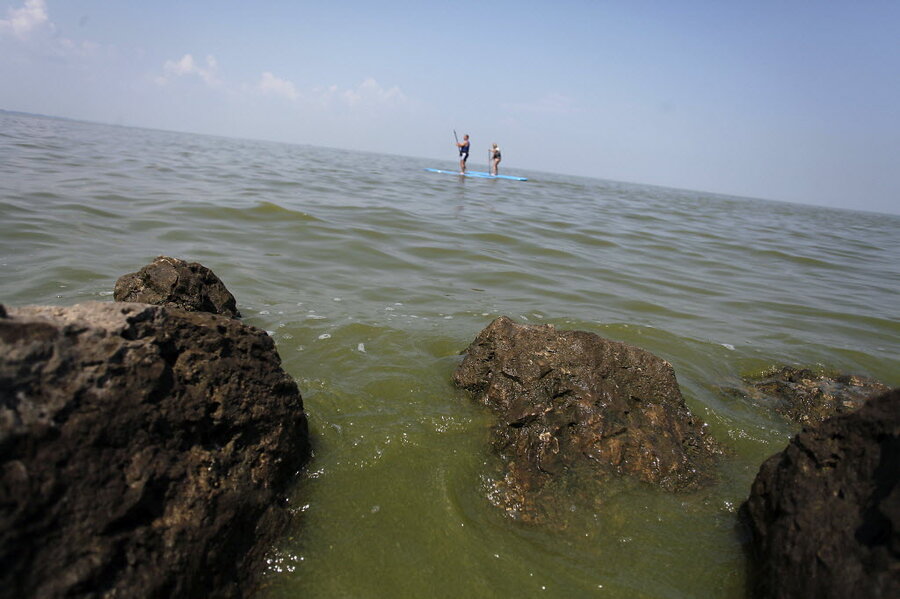Toledo water crisis may be over, but toxic algae blooms are in our future
Loading...
Once again, Lake Erie has vaulted itself into the national conversation about the environment – this time over the disruptive effects blooms of harmful algae can have on lakeside residents.
On Monday, Toledo Mayor D. Michael Collins pronounced the Ohio city's water fit for human consumption following two days in which levels of algae-based toxins in the city's lake-derived water supply were too high. The readings prompted a ban on using the water for drinking, cooking, even bathing, until the toxin levels fell back to acceptable levels.
These algae – bacteria known as microcystis – are found in bodies of freshwater to varying degrees throughout the United States, researchers say. And while it's unclear if there are any long-term trends in outbreaks, researchers say they are concerned that the conditions that contributed to the tap-closing Lake Erie bloom could eventually raise the stakes for people who rely on other lakes and reservoirs for municipal water supplies and for recreation.
"There is a perception that the frequency of occurrences has been increasing over the last several decades, but there's insufficient data to support that," says Keith Loftin, a research chemist with the US Geological Survey office in Lawrence, Kan., who works on the freshwater-bloom question.
Still, based on several national assessments conducted with the US Environmental Protection Agency, it's not a matter of if, but when surveyors will find toxin-producing blooms, he says.
The main driver for the blooms is available food – mainly nitrogen and phosphorus. But sources matter, explains Wayne Carmichael, a retired professor emeritus of biology at Wright State University in Dayton, Ohio, whose research focused on harmful algae blooms involving cyanobacteria and who still consults on the issue.
Into the early 2000s, Lake Erie blooms largely involved cyanobacteria that didn't produce toxins. They drew their nitrogen from the air and their phosphorus from a range of human sources – from factories to untreated or poorly treated sewage – which included phosphorous from laundry detergents as well as human waste. The Clean Water Act triggered a clean-up of these so-called point sources.
For a long time, the lake's cyanobacteria tended to be dominated by species that didn't produce toxins, Dr. Carmichael explains.
That changed, thanks in no small part to the arrival of invasive zebra and quagga mussels. They are filter feeders that thrive on plankton and algae. But they find microcystis singularly unpalatable, and so eject them. Over time, this changed the mix of cyanobacteria in Lake Erie waters, even as phosphorus and nitrogen from urban and agricultural run-off began to increase. Since microcystis doesn't extract nitrogen from the air, the run-off provided the bacteria with the nitrogen it needed.
Climate change also has played a roll, notes Gary Fahnenstiel, a research scientist at the University of Michigan's Graham Sustainability Institute in Ann Arbor and scientist emeritus at the National Oceanic and Atmospheric Administration's Great Lakes Research Laboratory, also in Ann Arbor.
Spring storms are becoming more intense, yet are occurring less frequently on average than they have in the past, he explains. Microcystis tends to settle on the bottom of the relatively shallow Erie. The storms stir up the lake, bringing the algae to the surface.
"That basically becomes the seed bank for the bloom, and during the calm period they bloom and grow," he says. Meanwhile, the rain provides the nutrient-laden run-off to feed the algae. Climate change also is extending the growing season, which can affect algae.
To be sure, conditions aren't replicated elsewhere to the same degree, and the amount of food available in some areas is dominated more by natural sources as from human sources.
Still, the greater the availability of nitrogen and phosphorus, the more conditions favor toxin-producing cyanobacteria, notes the USGS's Dr. Loftin. Moreover, the invasive mussels that tipped the scales in favor of toxin-producers in Lake Erie are spreading.
"We have zebra mussels in Kansas," he says. "They have moved down through many of the reservoirs through the Midwest."
One of the challenges to controlling blooms in most locations around the US is that one can cut off the current flow of nutrients from human sources "and there would still be enough nutrients to keep the issue going," Loftin says.
And while for relatively small bodies of water chemical controls can be applied to deal with a bloom – alum, for instance, can bind to phosphorus, fall to the bottom, and lock it in the sediment, although it too can be toxic – biological approaches seem to have the best long-term prospects for reducing the risk of toxic blooms, Loftin says. For instance, the risk of blooms can be reduced by using aquatic plants in surrounding wetlands to take up the nutrients.
Chemicals for blooms the size of the event Toledo endured would be far too expensive to contemplate, researchers say. Instead, the supply of nutrients to Lake Erie remains the main lever for reducing the risk of harmful algae blooms.
In February, for instance, the International Joint Commission issued a report recommending a range of measures, including significant reductions in dissolved phosphorous coming into Lake Erie from the US and Canada. The IJC was set up under a 1909 treaty between the two countries to advise them on ways to resolve issues involving the Great Lakes and other waters they share. In addition, the recommendations call for a 10 percent expansion of coastal wetlands at the lake's western end as one approach to reducing nutrients entering the lake.
The harmful-bloom issue in the nation's freshwater lakes and reservoirs "is something we need to address," Carmichael says. "We have the means. But these things cost money. Until people decide it's a high-enough priority, it's not going to get done."








